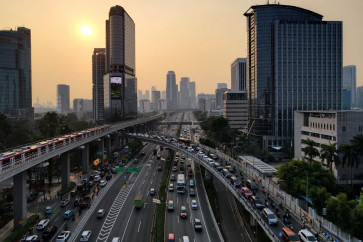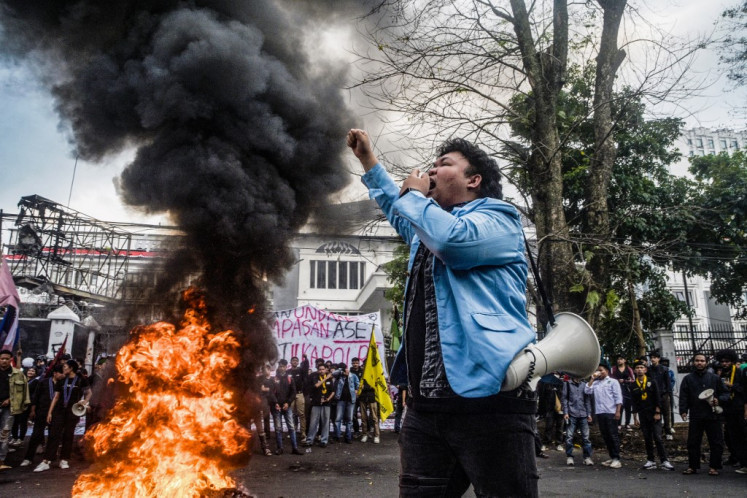Popular Reads
Top Results
Can't find what you're looking for?
View all search resultsPopular Reads
Top Results
Can't find what you're looking for?
View all search resultsPhilippine-held island in SCS suffers typhoon damage
Change text size
Gift Premium Articles
to Anyone
T
he deadly typhoon that killed hundreds in the Philippines has also damaged dozens of homes and government infrastructure on the country's biggest, most strategically important outpost in the South China Sea, including a newly built coast guard station.
Meanwhile, the rapid intensification that turned this week's Typhoon Rai into the strongest storm to hit the Philippines this year surpassed all predictions, forecasters said.
Typhoon Rai, which left nearly 400 people dead and displaced hundreds of thousands, hit the remote island of Thitu, one of nine features the Philippines occupies in the Spratly archipelago, just as it had been undergoing an upgrade to facilities, including the repair of a runway.
The island is located more than 483 kilometers from the Philippines.
"As soon as possible, we will rebuild the coast guard station," Philippine Coast Guard (PCG) spokesperson Armando Balilo told Reuters.
"We need Pagasa island. It is critical to our country," he said using the local name of the island.
Thitu's population of just 194 as of July has a strategic purpose for Manila — preserving a Philippine claim of sovereignty in the face of a resurgent China.
China claims sovereignty over the Spratlys, but Brunei, Malaysia, the Philippines, Taiwan and Vietnam all have competing claims on some or all of the islands.
Balilo said the island's residents were safe and that the PCG's priority was to send relief supplies.
Images shared by the coast guard showed the trail of damage left behind by Rai on Thitu, from uprooted trees to the roofs and walls of homes being torn off.
"Only the evacuation center was left standing, but the windows were also busted," Balilo said.
Rai, which struck the Philippines on Dec. 16, was the strongest typhoon to hit the archipelago this year. It has affected 1.8 million and displaced 630,000 residents, the United Nations Office for the Coordination of Humanitarian Affairs said.
It revived memories in the Philippines of the devastation brought in 2013 by Typhoon Haiyan, one of the most powerful tropical cyclones ever recorded, which killed 6,300.
Balilo said the PCG managed to reach Dinagat island, one of the southeastern provinces first pounded by the typhoon, on Tuesday, to deliver desperately needed relief supplies after residents had been pleading for food, water and shelter.
Rapid intensification
While it's unclear exactly how global warming is affecting the intensification of such storms, the UN's climate change agency has found it is "likely that the frequency of rapid intensification events has increased over the past four decades" as temperatures rise.
Before Rai underwent a process of rapid intensification, forecasters at first warned of a storm that could bring "considerable damage", with winds of up to 165 km per hour.
"But the situation evolved very fast," said Nikos Peñaranda, a forecaster who studies thunderstorms at the Philippines' national weather bureau, speaking on Tuesday.
"Our models weren't able to predict the way the storm intensified, and it exceeded all our predictions."
In rapid intensification of storms, warm ocean water and differing wind speeds near the eye of the storm act as fuel to whip it up into a more severe event.
In the case of Rai, the storm turned into a category 5 supertyphoon, with speeds similar to when a passenger airplane starts to lift off the ground.
When it made landfall, winds of up to 210 kph were uprooting coconut trees, ripping down electricity poles, and hurling slabs of corrugated tin and wood through the air.
A lack of real-time data and case studies of similar storms in the region made it difficult for forecasters to predict just how much Rai, or Odette as the storm is known locally, would intensify, said Peñaranda.
"The challenge in forecasting rapidly intensifying events is just that the speed with which this occurs, often in a matter of hours, leaves less time for disaster risk reduction mobilization and evacuations," said Clare Nullis, media officer specializing in climate change at the World Meteorological Organisation (WMO).
Hurricane Ida, a category 4 storm, experienced a similar intensification in the Gulf of Mexico hours before it slammed into the United States state of Louisiana in August.
Ocean temperatures near the surface and at depths of up to 200 meters are rising around three times faster in this region than the global average, according to the WMO, making it fertile ground for more intense, less predictable storms.
In the past three decades, the Philippines has recorded at least 205 tropical cyclones, the highest of any Asian country, according to EM-DAT, a publicly available database on disasters run by the University of Louvain. Nearly each one of has taken lives and caused millions of dollar worth of damage.
By comparison, China, the second-most affected country, has seen 139, and Bangladesh, also prone to storms, has seen 42.










